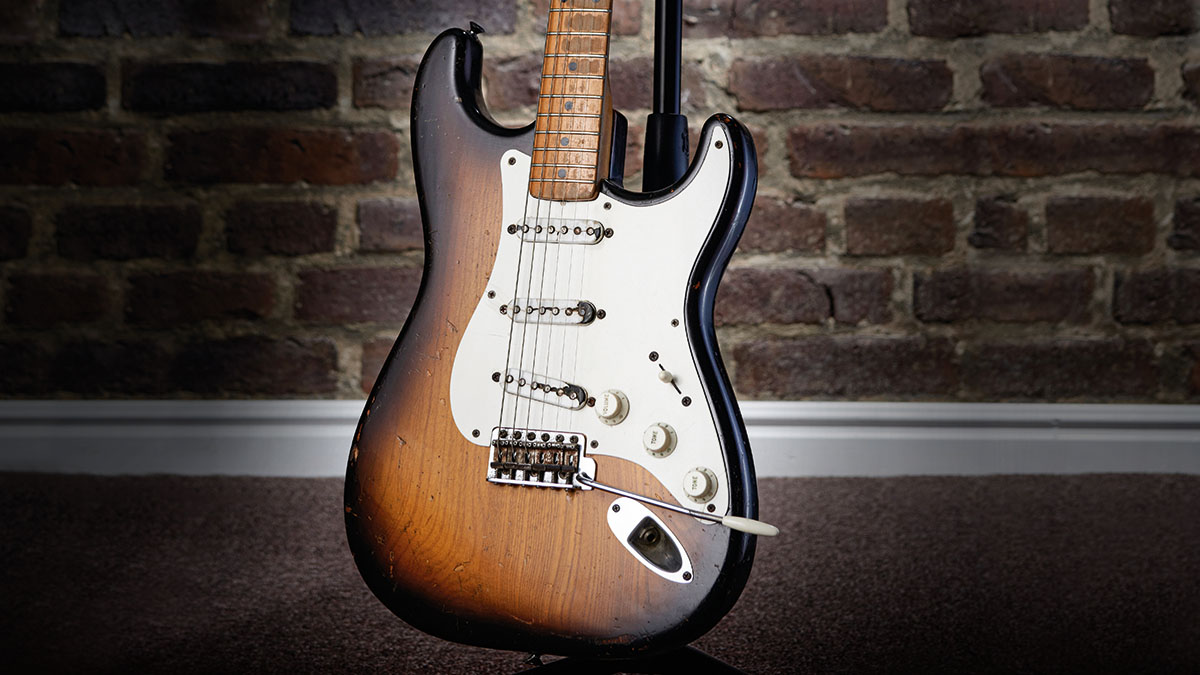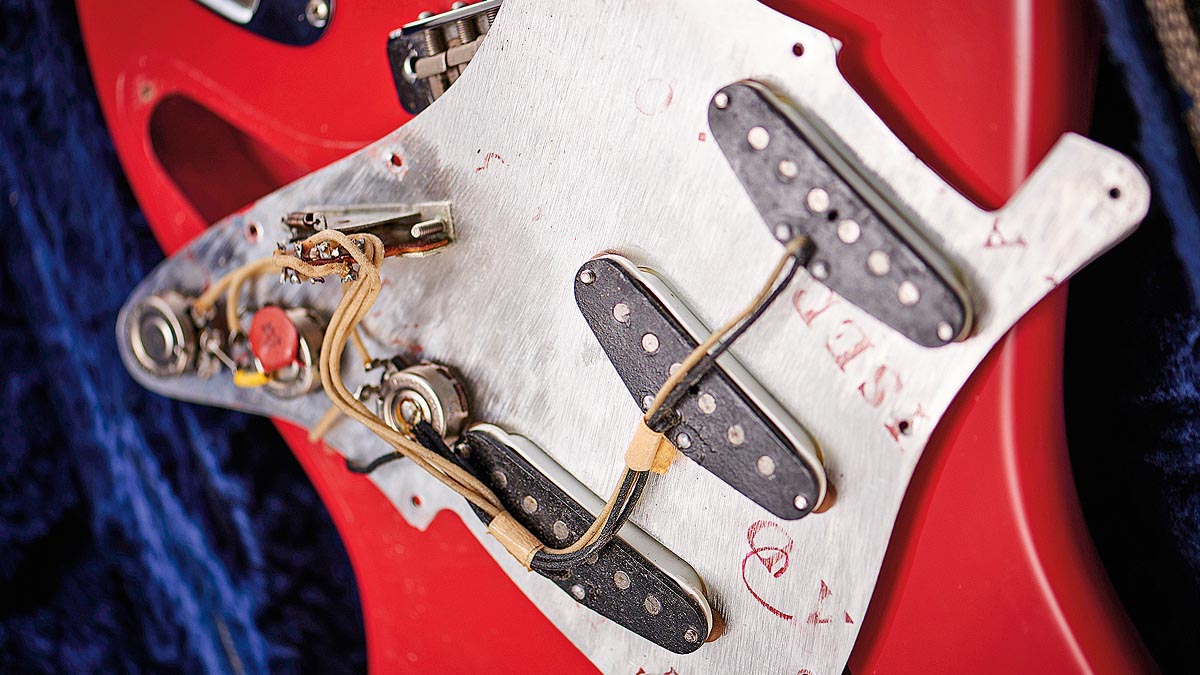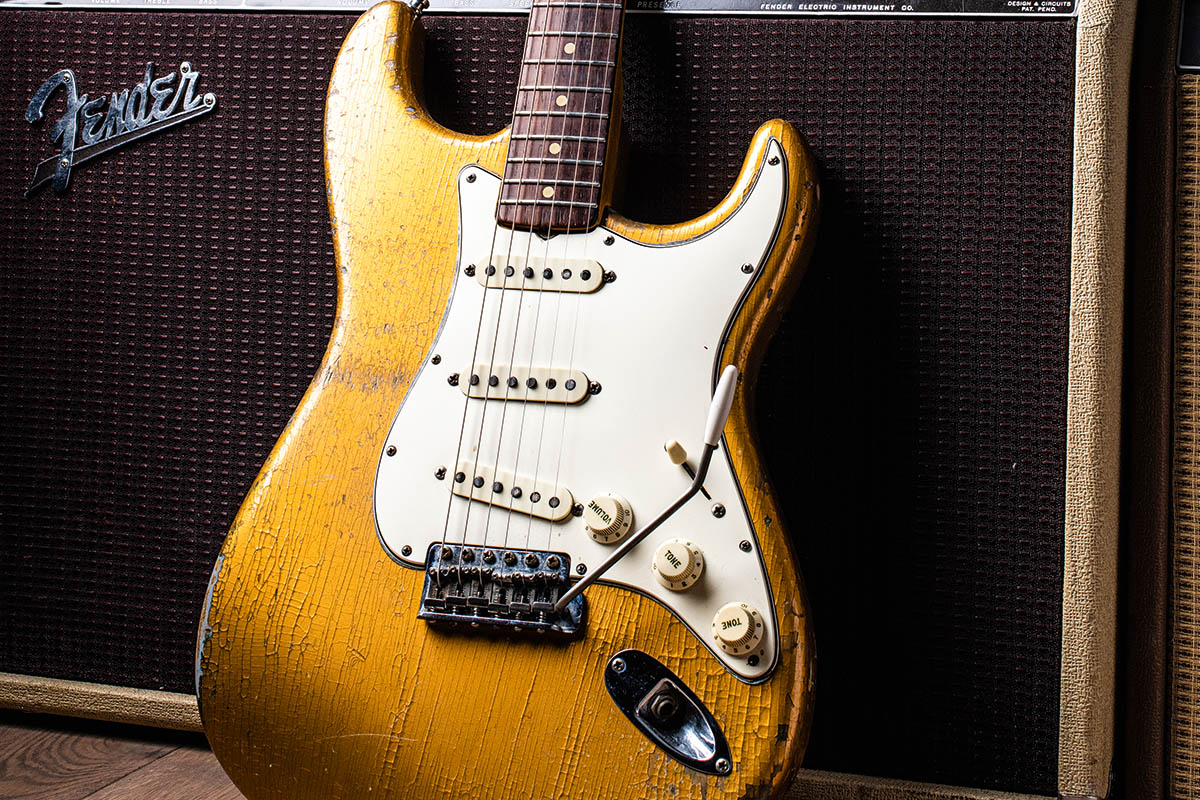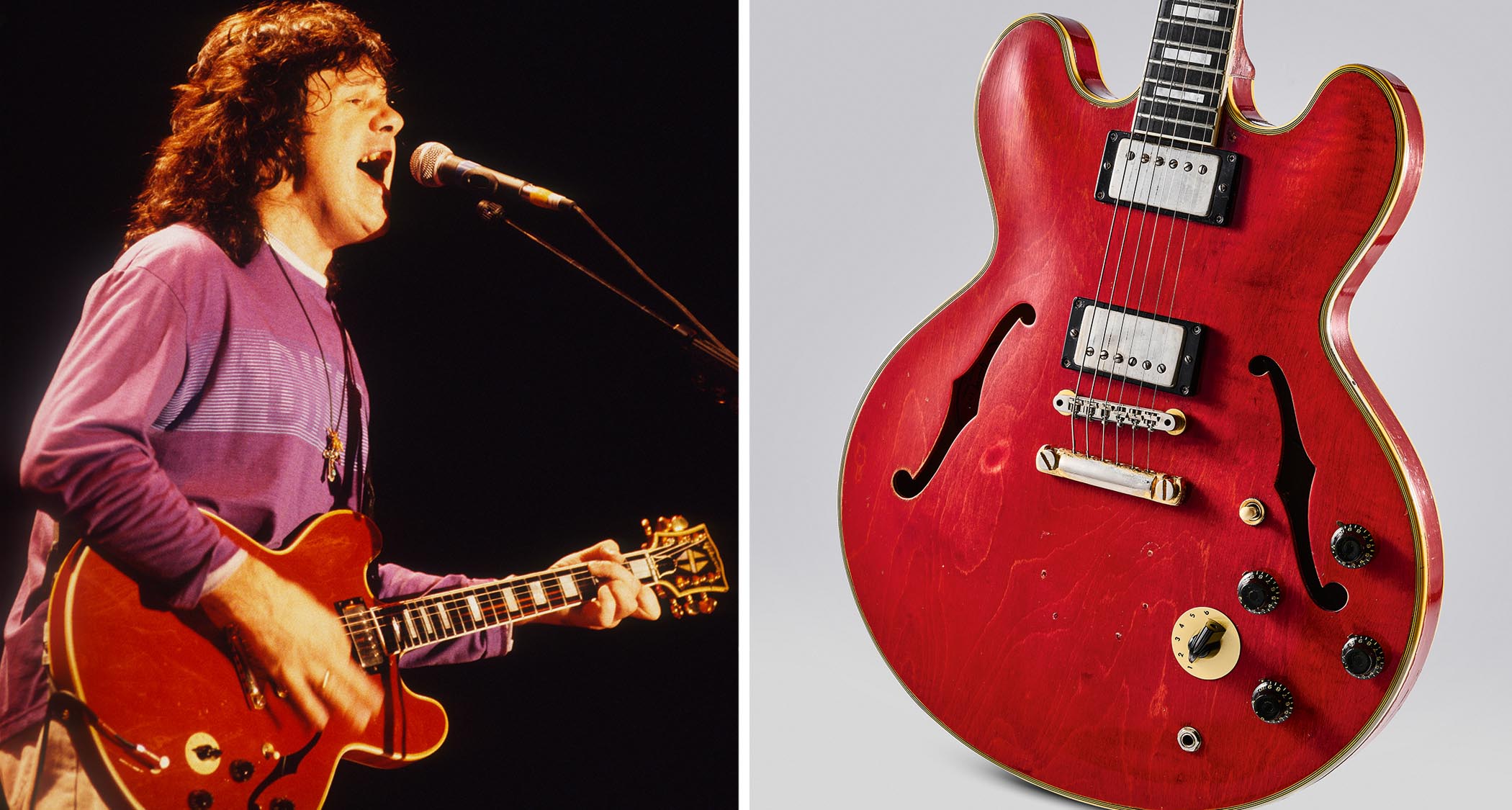
Nobody can deny that Leo Fender revolutionised the process of mass-manufacturing electric guitars. Routing out planks of wood to form bodies and attaching necks with screws represented a paradigm shift in 1949. A couple of innovative vibrato designs soon followed, but the fundamentals of Fender guitar construction were in place from the get-go and carried through into Leo’s work with Music Man and G&L.
Everything, that is, besides the pickups. Competitors such as Gibson and Gretsch tended to use just one or two pickup designs for all their guitars, but every new Fender model had bespoke pickups that weren’t used on any other instrument. Leo Fender’s pickup obsession lasted throughout his career, and his approach to pickup design continued to evolve.
The pickups that graced the Stratocaster design when it was launched in 1954 set the precedent. Being a great believer in prototypes, Leo provided Bill Carson with several for road-testing and, according to George Fullerton, the prototype design that went into production was chosen by Bill because they “had the most hair on their chest”.
Bill Carson also suggested installing four or five pickups on the Stratocaster, but Leo probably demurred on the basis of cost and common sense. Compared with their predecessors in the various T-style models, Strat pickups were simpler and presumably cheaper to manufacture.

Leo ditched the bridge inductance plate and the metal cover in the neck position. The component parts included two fibreboard flats, six magnetic slugs, two eyelets and a few thousand turns of magnet wire. Even so, Stratocaster pickups made in the 1960s and ’70s sound quite different from those made in the ’50s, and we can examine the component parts in greater detail to explain those differences.
On the flats
Leo Fender took an industrial approach to manufacturing and designed components using readily available materials wherever possible. Having started out in radio repairs, he would have been very familiar with vulcanised fibreboard. Also known as ‘fish paper’ and Forbon, it was commonly used for making eyelet boards for electronic components and had been standard in Fender amps since the mid-’40s.
Having also used fibreboard for Telecaster pickups and pickguards, Leo took the same approach for Stratocaster pickups. Two ‘flats’ were needed, with one on top and a slightly larger one on the bottom to accommodate height screw-holes, and two eyelets for connecting the start and finish wires of the coil to the leadout wires.
All the latest guitar news, interviews, lessons, reviews, deals and more, direct to your inbox!
The flat shapes were stamped out, along with holes for the magnetic slugs. These holes had to be precise to achieve a secure friction fit – and with the slugs installed, the whole assembly was dipped in lacquer to coat the slugs with an electronically insulating layer.

The bottom flats remained black until around March 1964, when they became grey. The grey was retained throughout the ’70s, becoming slightly darker along the way. However, for a period around 1968 Fender had supply issues and resorted to using up pre-CBS-era stocks of black-bottom flats.
Although pencil dates on the underside of pre-CBS Strat pickups are seen, they are not the norm. A yellow date-stamp was introduced in 1964 and can be seen on the very last black-bottom and first grey-bottom flats. Hand-written dates appeared in 1966, followed by a black date stamp by the late ’60s.
Slug fest
Unlike P-90, PAF and Filter’Tron pole screws, Stratocaster slugs are permanent magnets. Alnico III was used for very early Strats, but Fender had changed to Alnico V by 1955 and this has remained the default alloy for traditional Stratocaster pickups ever since.
Throughout the 1950s, the north end of the slugs protruded through the covers, but Fender changed to ‘south up’ around 1960. This is unlikely to influence tone, but it’s a useful test when you’re trying to authenticate vintage pickups.
In 1954 Telecaster slugs were still flat, but staggering Stratocaster pickup slugs was a big point of difference and certainly gave the sales team something to talk about. P-90s and DeArmonds were regarded as premium pickups during that era, and both had adjustable polepieces. Fender probably staggered the slugs to optimise string-to-string balance without complicating the manufacturing process.
At first the D slug was taller than the G slug because many players were still using wound G strings. Fender responded quickly when it became apparent that plain G strings were becoming the norm and lengthening the G slug improved the balance. This stagger is still used for vintage-style Fender pickups and boutique replicas.
Slug dimensions changed throughout the vintage era. In ’54 the diameter was 0.2 inches, but the slugs soon slimmed down to 0.192 inches and were further reduced to 0.1875 inches around the of middle 1962. Magnet diameter influences the shape of the field and so narrower slugs provide space for extra windings and potentially a higher DCR reading.
During 1974 Fender changed to non-staggered slugs and stopped hand-bevelling the edges at the top of the slugs. This tiny change was probably intended to reduce costs, but it alters the magnetic field shape and affects tone.
On the wire
If you compare coils made prior to 1964 with coils that were wound later, you’ll notice a colour difference. The orange-y copper look indicates magnet wire with heavy formvar coating, and darker purple/grey coils correspond with plain enamel coating.
Although the coating is incredibly thin, over 5,000 or 6,000 turns it influences the coil’s shape and size, which inevitably affects tone. Plain enamel is thinner than formvar, which equates to a smaller coil for the same DCR reading.

With more space between the wires, formvar coils tend to have different capacitance and inductance characteristics, which corresponds to a strong but clear and bright tone. In contrast, plain enamel coils tend to sound less airy but have smooth treble and full midrange. This remains pertinent because most high-end pickup winders still offer both types of wire.
Vintage coils were gradually wound hotter, starting out around 5.6kohms and averaging over 6k by 1963. There was a blip around 1959 when Stratocaster coils were wound a bit cooler and Tim Mills of Bare Knuckle Pickups reports that “the hottest Fender coils appear from ’62 to ’64”. Clearly, there were inconsistencies and, unlike modern sets, Strat pickups were installed randomly, rather than selected for each position on the basis of DCR.
Immortal coils
Prior to the CBS takeover, Fender pickups were hand-wound. This doesn’t actually mean they were wound by hand because each coil would take about a week. Fender did use coil-winding machines, but the wire was guided onto the bobbins by hand.
This process introduces a lot of variables and the wraps are more uneven and randomly distributed than fully automated winding. The tension of the coil also varies. The term ‘scatter winding’ is often used to describe hand-winding and it’s regarded as an essential ingredient for vintage Fender clarity and chime.
The pickups that graced the Stratocaster when it launched in 1954 set the precedent
Some of Fender’s pickup winders were regarded as having a special touch, with Abigail Ybarra being the most famous example. Fender brought her back into the fold to make limited numbers of pickups for Custom Shop models.
Fender’s switch to fully automated pickup-winding roughly coincided with the introduction of plain enamel wire and cooler coils. Although most vintage Strat fans may focus on pre-CBS models, it’s worth remembering that players such as Jimi Hendrix, David Gilmour, Walter Trout and Aynsley Lister have created fantastic tones with machine-wound Strat pickups.
Going to pot
Unlike Gibson pickups of the vintage era, Fender pickups were wax potted. This means they were dipped in melted wax, which impregnated the magnet wire to solidify the coils and prevent microphonic feedback.
Towards the end of the 1960s, Fender started dipping pickups in lacquer, rather than wax. This resulted in very solid coils and a tone that was harsher and more brittle than before. And in some cases, lacquer potting can backfire and make the pickups even more prone to microphonic squeal.
If you tap the cover of any unmolested pre-CBS Strat pickup you should hear the sound coming through your amp. They always tend to be somewhat microphonic, which some suggest enhances the treble shimmer and adds harmonic complexity. It’s interesting to consider whether they were always that way or whether the microphony is actually a symptom of wax degrading as the pickup ages.
Some pickup manufacturers are aware of this and can retain a degree of microphony by limiting the amount of time freshly wound coils spend in the wax. It’s worth discussing if you’re ordering a bespoke set from a smaller company – and if squeal sets in, your pickups can be returned for extra potting.
Summary
The apparent simplicity of Stratocaster pickups is deceptive and simply combining all the ingredients is no guarantee of great vintage-style tone. The strength of Alnico V magnets may differ from one manufacturer to another. And even if you can get a vintage-correct formulation, you will still need to consider gauss.
Individual winders all have their own style, so one maker’s hand-wound coils may sound different to another’s. Equally, modern formvar and plain enamel coatings may differ in thickness to vintage types, and years ago the gauge tolerances of the magnet wire may not have been as consistent as they are today. Good luck!
How to tweak your Strat pickups for better tone
Unlike modular P-90s and PAF humbuckers, the construction method limits the scope for modifying Strat pickups and we have to consider external factors. For instance, replacing rubber tubing around the height-adjustment screws may buy you a tiny bit more treble if your pickups sound a bit dark.
If your pickups sound too bright or harsh, however, ensure that you have a pre-CBS-spec 0.1µF tone capacitor installed, rather than a later-style 0.047µF. For authentic early 60s tones, an aluminium shielding plate will make a Strat sound marginally smoother and less spiky. It’s subtle but clearly audible if you have discerning ears, and at less than $/£20 there’s no point in not installing one.
Even Strat die-hards often complain that bridge pickups sound disproportionally thin and bright. That’s because it’s the only pickup that’s not bleeding treble through a tone control. So the easy workaround here is swapping the middle tone control to the bridge pickup by moving the connecting wire on the switch. Alternatively, you can jumper the switch tags for the middle and bridge pickups to share a tone control.
To really bolster the bass and low mods, and raise overall output, a Tele-style metal induction plate can be attached to the bottom of the pickup. Most players opt for the bridge, but it can be done to all three pickups if you prefer. Tape must be applied to prevent the plate from making an electronic connection with the slugs, and the plate has to be wired to ground. Some use glue or double-sided tape to attach the plate, but melted wax works, too.
Huw started out in recording studios, working as a sound engineer and producer for David Bowie, Primal Scream, Ian Dury, Fad Gadget, My Bloody Valentine, Cardinal Black and many others. His book, Recording Guitar & Bass, was published in 2002 and a freelance career in journalism soon followed. He has written reviews, interviews, workshop and technical articles for Guitarist, Guitar Magazine, Guitar Player, Acoustic Magazine, Guitar Buyer and Music Tech. He has also contributed to several books, including The Tube Amp Book by Aspen Pittman. Huw builds and maintains guitars and amplifiers for clients, and specializes in vintage restoration. He provides consultancy services for equipment manufacturers and can, occasionally, be lured back into the studio.

